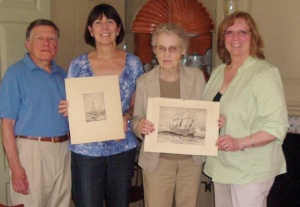News release from Milton Historical Society
The Milton Historical Society recently received a few etchings by Carl Wingate (1876-1946) who was one of America’s most famous marine artists. Suzanne Hart Sarr (whose mother was a first cousin to Carl Wingate), her daughter Linda Bresnahan-McCarthy and son-in-law Harry McCarthy visited Steve O’Donnell and Linda Pirie at the Suffolk Resolves House to present them with these etchings:
“Frederick Billings” (built in Camden ME in 1885) – dated 1928
“Small village with mountains in background” (Algeciras, Spain) – 5 impressions – 1917
“Racing off Cape Horn Dec. 1851” (Clipper ships ‘Sword Fish of New York’ and
‘Flying Fish of Boston’) – 1931
Boston Harbor – (motorboats, Boston Fish Market, etc.) – 50 impressions -Circa 1936
Carl Wingate was born in Brooklyn and lived in New York for most of his early life. He graduated from Columbia University and the National Academy of Design, and studied in Paris and Spain. Though he spent a good part of his life in Milton and Marblehead MA he traveled widely, especially in search of new ships to depict; however, he was living in Milton when he died in 1946.

Photo of Steve O’Donnell, Linda Pirie, Suzanne Sarr and Linda Bresnahan-McCarthy holding 2 of the etchings being donated to the Milton Historical Society.
Wingate’s works were exhibited in numerous museums and libraries, acquired for private collections, and reproduced in books and such magazines as YACHTING. Some of his works can be found in the Museum of the City of New York. He specialized in dry point etchings of clipper ships. Wingate exhaustively researched the history, construction and performance of cliper ships. That was reflected in his etchings, which are intricately and precisely detailed down to the smallest bit of ropework. He was a stickler for historical accuracy. He gave the same attention to the ocean’ s vagaries, placing his ships in tumultuous tempests as well as in placid seas.
In addition to his etchings, Wingate published several books of his work including The Dry Points of American Clipper Ships and Ship Ahoy!. The latter book, published in 1935, included stoies of old windjammers. Wingate, in fact, wrote widely about ships, both in articles and poems which he often illustrated.
Though nautical subjects were his preoccupation, he also produced many landscapes, as well as pictures of flowers, trees, building, and other outdoor subjects – always with his careful attention to mood and detail. He regularly sent friends and relatives postcards adorned with pen-and-ink sketches of scenes of the Marblehead harbor and local scenes of Milton and Wellfleet.
The Milton Historical Society is delighted to add these etchings to their collection of art work by Milton artists and at a future time plan to exhibit them at Milton Public Library.